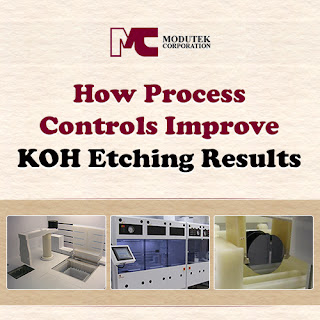In semiconductor manufacturing, pre-diffusion cleaning removes microscopic particles from the surface of the silicon wafer, leading to high-quality output and reduction of defect rates.
Why is pre-diffusion cleaning of the wafers important? As silicon microstructures are designed with smaller elements and with a higher component density, adequate wafer cleaning becomes more critical. Particles that remain in the wafer can prevent even diffusion and may themselves be diffused into the silicon, causing defects.
Several cleaning steps using different processes are sometimes required to achieve a specific level of cleanliness. The goal of pre-diffusion cleaning is to obtain wafers free from organic or metallic contamination and with few surface particles as possible.
Silicon wafer cleaning can be carried out in many ways:
- RCA Clean, which uses two steps:
o Standard Clean 1 (SC1) - The wafers are placed in a mixture of ammonium hydroxide and hydrogen peroxide. The corrosive mixture removes organic matter but may leave metal ions behind.
o Standard Clean 2 (SC2) - The remaining metal ions are removed by immersing the wafers in a mixture of hydrochloric acid and hydrogen peroxide. At the end of the wafer cleaning process, organic and metallic contamination has been removed while as many remaining particles as possible are rinsed away as well.
- Piranha Clean – It cleans heavily contaminated organic materials (such as photo resist) faster than RCA Clean. The wafers are immersed in a mixture of sulfuric acid and hydrogen peroxide and the mixture may be heated up to speed up the reaction.
- Megasonic Cleaning – Megasonic cleaning is an ideal alternative to RCA Clean and Piranha Clean, since it doesn’t use corrosive chemical baths in cleaning the wafers. Instead, the megasonic process works by generating high-frequency electronic signal and a transducer converts the signal into sound waves that travel through the cleaning solution. The sound waves carry cavitation bubbles that produce a scrubbing action against the surface of the silicon wafer. The action of the bubbles cleans the wafer. Megasonic silicon wafer cleaning operates in the frequency range near or above 1 MHz and the cavitation bubbles agitate the cleaning solution at the operating frequency. Such agitation breaks the bond holding the particle on the wafer surface and the floating particles can be rinsed away.
Read our complete article, The Importance of Pre-Diffusion Cleans in Silicon Wafer Cleaning, to learn more about the process. You can also contact Modutek to discuss your questions or get a free consultation by sending an email to sales@modutek.com or by calling 866-803-1533.

